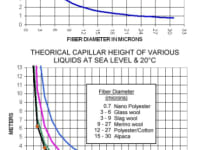This is an adaptation of an ancient system used in the Peruvian Andes to filter solids and transport water since 5,000 years ago. It makes use of two free forces of nature, adhesion and gravity via the well known capillarity and siphon effects using fiber filled conduits.
The objective of this adaptation is the production of alcohol from agricultural products at a small scale using common materials obtaining great savings in material preparation and the energy required to heat big volumes of water uneccesarily. Currently most of the distillation units available make use of pumping, filtering, and heating big volumes of liquid.
Although this design was originally made for poor agricultural families in isolated places in order to produce a usable / saleable commodity as alcohol, it can be scaled up to industrial level. The market potential is huge, since alcohol (Ethanol and Methanol) rival with gasoline. Alcohol can also be used for generating electricity in micro turbines in small villages.
The process is simple: After fermenting agricultural goods, withouth filtering the solution, the alcohol present in the same can be distilled by inmersing a flexible pipe filled with fiber. The liquid will ascend by capillarity up to a capsule where a heating source (electric, flame, solar) will make alcohol to evaporate.The excess water will be "pulled out" by the controllable siphon effect in the other end of the pipe. Design controls are : fiber type, fiber compaction, height of capillarity end, depth of siphon end. Our tests indicate that 50 - 60% of the theorical is easily achievable, producing a 95% alcohol (depending on materials, mostly is ethanol, but some methanol is also present)
The design is so simple that can be manufactured elsewere, even with rudimentary knowledge. Materials to be used, plastic, fiber etc. are cheap materials. If nano fiber is used then cost will increase. Being a simple design with materiales readily available, that can be used at very small scale in poor and isolated areas of the world to improve de quality of life by generating from agricultural crops and refuse a clean fuel that becomes a money earning commodity (alcohol) According to FAO about 30% of crops in poor areas are lost by lack of access to markets.Alcohol is a commodity.
This design will lead to other product improvements, as the use of capillar siphons which energy comes from the combination of capillarity (adhesion) and gravity (siphon) will allow further developments in water sanitation & potabilization, filtering difficult solids, and water desalinization, among others. Lab tests done in desalinization using cotton fiber are promising. A rough idea is included in the graphics.
Like this entry?
-
About the Entrant
- Name:Pedro Flecha
- Type of entry:individual
- Hardware used for this entry:PC CompaqSoftware used for this entry:Excel, Paint Shop Pro
- Patent status:none








